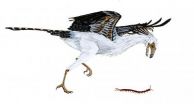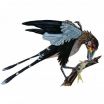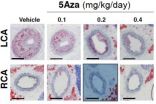(Press-News.org) Birds come in astounding variety—from hummingbirds to emus—and behave in myriad ways: they soar the skies, swim the waters, and forage the forests. But this wasn't always the case, according to research by scientists at the University of Chicago and the Field Museum.
The researchers found a striking lack of diversity in the earliest known fossil bird fauna (a set of species that lived at about the same time and in the same habitat). "There were no swans, no swallows, no herons, nothing like that. They were pretty much all between a sparrow and a crow," said Jonathan Mitchell, PhD student in the Committee on Evolutionary Biology, and lead author of the new study, published May 28, 2014, in Proceedings of the Royal Society B.
The scientists examined a group of bird fossils dating back to the Cretaceous period, around 125 million years ago, relatively soon after the emergence of birds. The fossils were collected from an area in China where there was once violent volcanic activity, leading to a plethora of well-preserved fossils as intermittent eruptions periodically killed many birds. The researchers examined the diversity of species in this sample. However, because fossils indicate only the physical characteristics of the birds, understanding the diversity in how the birds behaved required significant scientific legwork.
To tease out the ecological roles played by the prehistoric birds, the researchers used modern-day birds to build a statistical technique that could relate the physical characteristics of a bird to its diet, behavior and habitat. Long legs might be associated with birds that wade through water, for instance, and the shape of the beak might hint at what the bird ate. For this purpose, the scientists painstakingly measured 1,400 modern birds—mostly from the Field Museum's collections—and extracted the correlations between these measurements and the birds' behavior.
Toothy birds
However, the scientists still had to show that this technique, which was useful for modern birds, could be applied effectively to the distinct sample of ancient birds. "These birds are very different from modern birds—some of them have teeth, some of them have long bony tails," said Mitchell. Therefore, it wasn't clear if the method would translate.
In order to test the method, they looked at the contents of the birds' stomachs—the last meals they ate before their demise—which in some cases had survived the process of fossilization. They found agreement between the method's predictions and the birds's diet, indicating that it worked for ancient birds as well.
Once they had confirmed that the method was effective for the fossil birds with food preserved in their bellies, the scientists applied their method to the full complement of the region's bird fossils. They found that these early birds were less diverse than modern birds. In particular, larger birds and water birds were lacking. "They were all pretty much the same. They were ground-dwelling or forest-dwelling little birds, mostly eating insects and seeds," said Mitchell.
Fossilization bias?
A possible confounding factor was the bias potentially introduced by the fossilization process. Some types of birds might become fossilized more often than others, artificially reducing the diversity. To examine this possibility, the scientists compared very recent bird fossils to the populations of modern-day birds. They found that the fossilized sample was less diverse, although not enough to explain the effect they had seen in the very old fossils.
Additionally, the fossils were biased towards larger birds, and birds that lived in water. That is the opposite effect from the one seen in the oldest fossils, which were mostly composed of small land-dwellers, so the scientists concluded that this bias could not be the cause of the homogeneous birds.
The scientists' research is beginning to untangle some possible reasons for this lack of diversity. One feasible explanation is that early birds were less diverse due to competition with similar groups—such as the prehistoric flying reptiles known as pterosaurs. But the scientists used an evolutionary model to show that the paucity of ecological niches could be explained simply by the fact that birds were new to the scene, and thus hadn't had time to diversify. "It looks like they just hadn't evolved the crazy diversity of ecologies that we see in modern birds," said Mitchell.
The research was carried out through UChicago's Committee on Evolutionary Biology, an interdisciplinary graduate program, which allows for collaborative work between students at the university and outside research institutions such as the Field Museum. Peter Makovicky, associate curator of paleontology and chair of the Field Museum's department of geology, was co-author. The program, Makovicky said, is a great place for students to "really tackle these big-picture questions."
The results have implications for when and how birds originated—a topic under some debate—as well as for the study of evolution in general. "In a broader sense, I think that our research speaks to an understanding of how groups of organisms, which are perhaps dominant today in modern ecosystems, get to that point," Makovicky, said. Birds, for example, evolved from humble beginnings into the diverse group we know today. The early bird, therefore, may indeed have gotten the worm—or the insect or seed—but not much else.
INFORMATION:
Citation: "Low ecological disparity in early Cretaceous birds," by Jonathan H. Mitchell and Peter J. Makovicky, May 28, Proceedings of the Royal Society B.
Funding: National Science Foundation.
Prehistoric birds lacked in diversity
2014-05-28
ELSE PRESS RELEASES FROM THIS DATE:
Cod bones reveal 13th century origin of global fish trade
2014-05-28
London's international fish trade can be traced back 800 years to the medieval period, according to new research published today in the journal Antiquity.
The research, led by archaeologists from UCL, Cambridge and UCLan, provides new insight into the medieval fish trade and the globalisation of London's food supply.
Archaeologists analysed data from nearly 3,000 cod bones found in 95 different excavations in and around London. They identified a sudden change in the origin of the fish during the early 13th century, indicating the onset of a large-scale import trade.
Lead ...
Butterfly 'eyespots' add detail to the story of evolution
2014-05-28
CORVALLIS, Ore. – A new study of the colorful "eyespots" on the wings of some butterfly species is helping to address fundamental questions about evolution that are conceptually similar to the quandary Aristotle wrestled with about 330 B.C. – "which came first, the chicken or the egg?"
After consideration, Aristotle decided that both the egg and the chicken had always existed. That was not the right answer. The new Oregon State University research is providing a little more detail.
The study, published today in Proceedings of the Royal Society B, actually attempts to ...
Should sugary drinks carry a health warning?
2014-05-28
In a personal view published on bmj.com today, a professor of public health at a leading university thinks there should be health warning labels on sugary drinks.
Professor Simon Capewell, professor at the University of Liverpool, highlights that the State of California is considering a new health bill. One which will see sugary drinks labelled with health warnings, vending machines to bear warning labels, and fines of between $50 and $500 per failed inspection".
Professor Capewell thinks this is a good idea, and one that the UK public would support.
He says that ...
Higher NHS spending in deprived areas can reduce health inequalities
2014-05-28
A policy of higher NHS spending in deprived areas compared with affluent areas is associated with a reduction in absolute health inequalities from causes amenable to healthcare in England, suggests a study published on bmj.com today.
In 1999, the government introduced a new 'health inequalities' objective for the allocation of NHS resources in England, which resulted in greater NHS spending in deprived areas with the worst health outcomes. But it is not known whether this policy was successful in contributing to a reduction in health inequalities.
So researchers based ...
School scheme unable to boost healthy eating and activity among kids
2014-05-28
A school-based scheme to encourage children to eat healthily and be active has had little effect, conclude researchers in a study published on bmj.com today.
The findings have relevance for researchers, policy makers, public health practitioners, and doctors, and they suggest that more intense interventions may be required.
Low levels of physical activity and of fruit and vegetable consumption in childhood are associated with adverse health outcomes. School based interventions have the potential to reach the vast majority of children, and evidence reviews have suggested ...
Barriers to HIV testing in older children
2014-05-28
Concerns about guardianship and privacy can discourage clinics from testing children for HIV, according to new research from Zimbabwe published this week in PLOS Medicine. The results of the study, by Rashida A. Ferrand of the London School of Hygiene & Tropical Medicine and colleagues, provide much-needed information on how to improve care of this vulnerable population.
More than three million children globally are living with HIV (90% in sub-Saharan Africa) and in 2011 an estimated 1000 infant infections occurred every day. HIV acquired through mother-to-child transmission ...
Making research findings freely available is an essential aid to medical progress
2014-05-28
In a PLOS Medicine guest editorial, Paul Glasziou, Professor of Evidence-Based Medicine at Bond University in Australia, explores how open access publications could help moderate and reduce the vast waste of global medical research.
Continuing on from his previous work, which highlighted how most of the world's expenditure on medical research was thrown away, Glasziou outlines how bad the situation is and suggests how it might be improved. Subscription-based academic journals make money by through copyrights assigned by authors to publishers who lock the articles behind ...
Dealing with stress -- to cope or to quit?
2014-05-28
Cold Spring Harbor, NY – We all deal with stress differently. For many of us, stress is a great motivator, spurring a renewed sense of vigor to solve life's problems. But for others, stress triggers depression. We become overwhelmed, paralyzed by hopelessness and defeat. Up to 20% of us will struggle with depression at some point in life, and researchers are actively working to understand how and why this debilitating mental disease develops.
Today, a team of researchers at Cold Spring Harbor Laboratory (CSHL) led by Associate Professor Bo Li reveals a major insight ...
Intertwined evolution of human brain and brawn
2014-05-28
The cognitive differences between humans and our closest living cousins, the chimpanzees, are staggeringly obvious. Although we share strong superficial physical similarities, we have been able to use our incredible mental abilities to construct civilisations and manipulate our environment to our will, allowing us to take over our planet and walk on the moon while the chimps grub around in a few remaining African forests.
But a new study suggests that human muscle may be just as unique. Scientists from Shanghai's CAS-MPG Partner Institute for Computational Biology, together ...
Disturbance in blood flow leads to epigenetic changes and atherosclerosis
2014-05-28
Disturbed patterns of blood flow induce lasting epigenetic changes to genes in the cells that line blood vessels, and those changes contribute to atherosclerosis, researchers have found. The findings suggest why the protective effects of good blood flow patterns, which aerobic exercise promotes, can persist over time. An epigenetic change to DNA is a chemical modification that alters whether nearby genes are likely to be turned on or off, but not the letter-by-letter sequence itself.
The results are scheduled for publication in the Journal of Clinical Investigation.
Atherosclerosis ...





